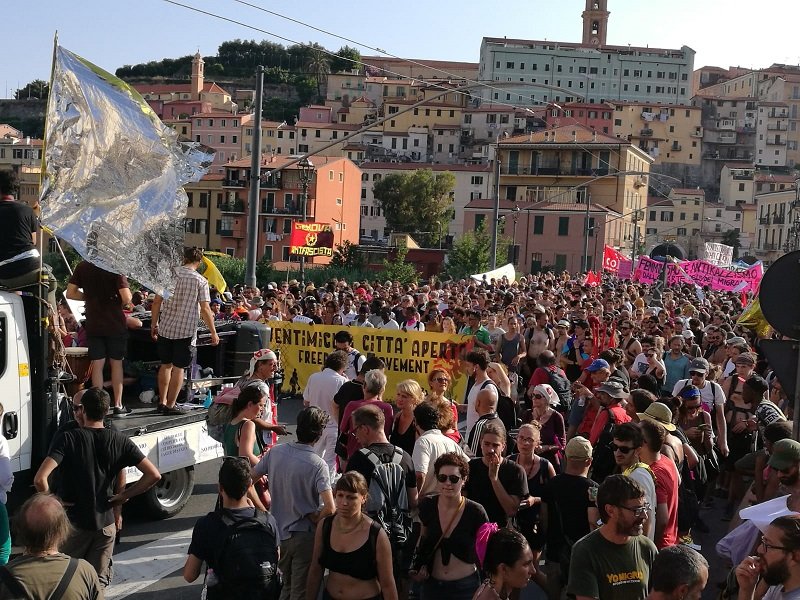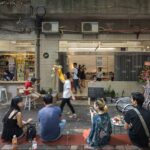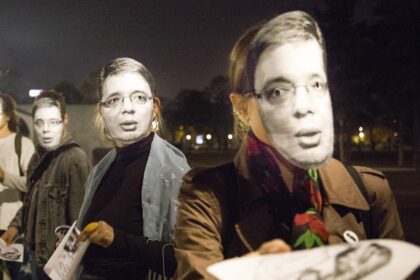Italian Blow-Up: Building Counter-Hegemonic Social Art Machines Against Reactionary Populism
By Marco Baravalle
Venice, Italy (Southern Europe)
2017 and 2018 marked two important anniversaries for Italy: fifty years ago the “long Italian ’68” began and eventually stretched until the uprisings of the precarious metropolitan youth in 1977. And maybe because of these anniversaries, we are witnessing the appearance of an unprecedented number of studies on the intertwining of art, society and politics during the 60s and 70s in our country. What is to be hoped for is that this attention will generate a knowledge exceeding the boundaries of the academy: this would be precious material for a collective reflection on the conditions of the past, in order to find new ways of operating in the present.
In 1968, the politicization of everyday life had a strong impact on art. Artists began to experiment with new processes of production that questioned the individual status of creation, the separation of the aesthetic sphere and the traditional circuits of cultural distribution. Some of these artistic experiments were comparable to what the Operaists called workers’ inquiry and co-research (both are forms of militant research in which the production of knowledge is one with the work of political organization). Rather than representing the struggles, artists began to work together with the participants, abandoning institutional art spaces to go where conflict was happening.
But why is a comparison with the concept of co-research worth undertaking? A simple methodological similarity would not be enough and it is also important to underline that there was no ethnographic or paternalistic purpose of this work, instead the artists’ goal was political: the subversion of hegemonic forms of art.
During the 70s up until the 1977 movement, the development of feminism, the disruptive use of creativity through the foundation of free radio stations, the production of militant magazines, and the reinvention of media were driving forces for the radicalization of the conflict. Artists participated too, but it is important to note that more than individual names, this period of mobilization is now remembered for acts of creation that are presented as the result of a subversive social cooperation: free radio stations, magazines, and the conception of language as a decisive political battleground.
It should not be forgotten that during the 60s, examples of an unprecedented relation between art and politics were possible because institutions were forced by social conflict to open up space for experimentation. Similarly, in 1977, the refusal of work became a vast social phenomenon that also infused artistic production. Today it seems these same conditions are very far from recurring. Cultural institutions look like monolithic neoliberal entities able to absorb critique; public funds for culture are irrelevant and the refusal of work is a political weapon very difficult to activate at the heart of the copious army of surplus art laborers.
So, if we have to look at present conditions to “stay with the trouble,” as Donna Haraway puts it, then the question is: how is the social field of art reacting to the reactionary wave that eventually reached Italy with the recent formation of the populist, right wing government of Lega Nord and Movimento 5 Stelle? A government de facto led by the deputy prime minister and minister of the interior, Matteo Salvini, who built his success on the adoption of a nationalistic and openly sexist, racist, and anti-social movement rhetoric, a politician who, according to polls, is gaining further consensus by closing our ports to migrants and by advocating the ethnic profiling of Roma people.

Let’s be clear, migrants died at sea and were imprisoned and tortured in countries like Libya and Turkey even under former social democratic governments. The difference is that what was previously justified through the category of humanitarianism is now fully claimed within a discourse of ethnic primacy of the “Italian People” (i.e. male, heterosexual and white Italians).
So far, at least on the surface, it looks like the art field is almost immobile, and this comes as no surprise. Indeed we are aware of the fact that art, as a dispositif, functions at the crossroads between neoliberal capture (where “subversive” creation is absorbed by cultural industries) and individuation (where the subjectivization of the cultural operator as an indebted entrepreneur of the self is still hegemonic). That does not mean that the institutional global art circuit is somehow lost, but it is important not to mix up a space of conflict with a space of acquired freedom. Still, under these circumstances, it would be naïve to expect an uprising of the Italian cultural world.
Once more what is needed is a new wave of mass social mobilization that, first of all, refuses to enclose itself within the discourse of sovereignty and nationalism, and that also refuses the reductive nature of populism. This is a temptation that surfaces here and there in the Italian left’s debate, but that represents in fact a reaction to fear generated by the identitarian turn of our continental space. It is particularly frightening to those who uncritically enjoyed the last several decades of freedom of movement in Europe and that now paradoxically blame those movements that prioritized transnationalism as the potential space for radical democracy and constituent processes. This fear represents a perfect space for the political activation of aesthetics, but a deep rethinking of what the word activation actually means would be necessary.
Today, in the arts, “business as usual” works as a sort of anesthetic, but in the midst of a reactionary phase, the domesticating role of cultural industries bears a heavier responsibility than before. By “business as usual” I mean the well-established mannerism of social or “political art” as an ingredient of the neoliberal art system.
This year’s Venice Biennale of Architecture, for example, introduced itself with a title full of promise: Freespace. However, its critical potential was immediately disarmed by the curators’ reference to “a generosity of spirit and a sense of humanity at the core of architecture’s agenda.”[1] Seriously? Is it because of “generosity” that we are witnessing an unprecedented intertwining between our built environment and private financial capital? That our cities are more and more wounded by gentrification? Is it generosity (or the lack of it) in general, a category that is politically acceptable when one thinks of the need for free space? And indeed this year’s exhibition presents itself mostly like a long sequence of architecture firms, a gallery of models. The cherry on top is represented by Robin Hood Gardens: A Ruin in Reverse. The project, curated by the V&A Museum, is based on the shipment and partial reconstruction (in the area of the Arsenale) of a demolished part of the Robin Hood Gardens, one of the most famous public housing estates in London, designed by Alison and Peter Smithson and completed in 1972. This example, which generated protests and critical reactions both in Venice and London, is the umpteenth example of cultural institutions offering themselves as spaces for critical debate, while at the same time, working in agreement with neoliberal urban agendas that, more so than generosity, find at their core the seeking of ground rent.
But, as I argued above, institutional space is not totally pacified. During the last few decades, especially with regards to performative arts and theatre, some events have been working as actual laboratories for radical aesthetics. This is the case with Santarcangelo Dei Teatri, held in a small village in central Italy. During its nearly fifty years of existence, this festival affirmed itself as a point of reference for some of the most innovative forms of performance, and for a type of critical discourse otherwise ignored by the academy and by the circuits of major public theatre. Accusations of obscenity and complaints about scandalous performances have been leveled against the festival since its early years, yet these accusations never led to actual censorship. The last edition, curated by Eva Neklayeva, centered around the theme of queerness, and attracted the attention of an Italian right wing member of parliament, who criticized a performance that staged nude actors in the central square of the town. This bigot’s institutional attack was amplified by social media in even more violent terms. The question is: will these acts of hostility remain free of consequences? Or, in this mutated cultural climate (where heteronormativity and the reference to “our Christian roots” once more occupy the center of political discourse), will they be followed by further cuts to public funding, and by the occupation of these spaces by reactionary curators and directors? What will prevail, governmentality or polarization?
Of course the two options will continue to coexist, but it is nonetheless necessary to collectively reflect on this question, and on this transition towards more authoritarian forms of capitalism. Especially because this shift is immediately relevant in terms of culture, symbols, languages, identity, communication, and imagery, while in contrast, social measures that require significant funding are encountering numerous obstacles. Looking at the recent actions of the Italian government, for example, it is clear that the electoral promises of a radical wealth redistribution (mainly the proposal by the Five Star Movement to activate a basic income) were very soon reduced to the status of workfare tools, in which welfare benefits have become dependent upon the acceptance of poorly paid jobs, community service or training. It is clear that such a “basic income” would not represent a liberation tool, but instead, a tool for work-force control.
On the other hand, an alarming project of cultural transformation proceeds much faster, saturating the social landscape of language with all the known elements of a toxic reactionary narration. So the problem is not to claim an “art for all” or an “art for the people.” Instead we need to open up new possibilities to politically activate the aesthetic dimension against the aforementioned toxic narration.
And indeed, in recent years, Italy saw the development of several initiatives that tried to suggest new possibilities for radical aesthetics, including S.a.L.E. Docks (Venice) and Macao (Milan). Both were born when artists and activists, years ago, occupied two empty public spaces, a former salt warehouse in the Lagoon-city, and an abandoned slaughterhouse in the capital of Italian fashion. Venice and Milan are very different places, but both are sites where gentrification violently affects the lives of inhabitants, and where the art economy and creative industries propel real estate and are closely tied to international financial capital. The goal of these two spaces is to experiment with a new model of art institutionality—what I have elsewhere defined as alter-institutionality.[2]
This means experimenting with modes of artistic production that respond to radical desires, and working to create more democratic governance models, more inclusive economies, and links between artists, art pieces and different activist or social realities. It also means working to bring art closer to self-organization than to gentrification, producing situated critical knowledge, resisting capture, fighting authoritarian, sexist and racist forms of culture, and reopening spaces instead of emptying them. It would be ideal to mention at least one project corresponding to each of these radical desires, but for reasons of space, it is impossible to do so here.
What is certain is that we have challenging times ahead and that as art or cultural operators, we need to look for new ways to escape this populist and nationalistic version of capitalist realism. If, according to Gregory Sholette, we are experimenting with life in a bare art world, [3] then let’s accept our nudity, not as an immutable fact, but rather as a set of conditions that need to be investigated and subverted. What can we do not only in the face of nationalism, sexism, and thousands of human beings left to die in the middle of the Mediterranean, but also in the face of the apparent loss of art’s autonomy from capitalism? It is necessary, and I will come back to this point, to experiment with new ways to politically activate aesthetics.
First of all, in terms of co-research, inquiry and organization: we need to put together an alter-institutional infrastructure that does not exclude official art institutions, but that also does not totally rely upon them. We need to rethink “social art” not only in terms of critique of the usual roles (artist, curator, manager, etc.) and dispositifs (the biennial, the festival, etc.), but also in terms of the neoliberal mobility of art. These models have trapped us in a solipsistic endless movement through an (almost) borderless space, where political and radical discourse recur as a background soundtrack, but where forms of organization are made extremely difficult.

We need to take seriously those artistic attempts that try to break with the worn-out habit of retreating to microtopias, where paternalistic artists and curators work with “communities,” exoticizing “the locals” and, at the same time, positioning themselves in the comfort zone where no general critique is possible. Today artists are again imagining alternative futures starting from a materialistic critique of the present. I’m thinking, for example, about the project All Work And No Play Make Jack a Dull Boy. All Play And No Work Make Someone Else a Rich Boy, which we recently curated at S.a.L.E. Docks. For the occasion, The Institute Of Human Obsolescence [4] presented Data Production Labor, an installation that reflected on the present ontology of labor and suggested the creation of a Data Workers Union. Macao, the art-activist collective based in Milan, participated with the piece Crypto Rituals, a series of drawings and diagrams that presented the project of a crypto-currency that embodies values of mutual care, in which digital programming and feminist rituals meet. Last but not least, Danilo Correale presented a new version of Reverie: On the Liberation From Work, a video and sound installation that uses hypnosis as a possible subjective decolonization tool, towards a post-work society in which universal income becomes a reality.
These are only a few recent examples of a renewed interest expressed by artists and collectives in imagining tools to intervene in the present towards a post-capitalist future. It is our collective responsibility to prevent these acts of creation from sliding towards a parody of historical avant-gardes, and we must also avoid any futuristic misunderstanding which would condemn them to the status of harmless products. These acts of imagination are political because they are breaking the frame of capitalist realism, from both the perspective of the governmental cage of microtopias, and from that of the orthodox blue-chip art piece produced by the individual artist-entrepreneur.
Our first task, then, is to recognize this potential and to be able to turn it into a social and counter-hegemonic cultural machine.
Marco Baravalle is a member of S.a.L.E. Docks, a collective and an independent space for visual arts, activism, and experimental theatre located in what was an abandoned salt-storage facility in Dorsoduro, Venice. Founded in 2007, its programming includes activist-group meetings, formal exhibitions, screenings, and actions. In addition to managing the diverse programming at S.a.L.E. Docks, Baravalle is currently a research fellow at IUAV University of Venice. His fields of research include the relationship between art, theatre and activism, creative labor, gentrification, and the positioning of art within neoliberal economics.
Notes:
[1] From the “Freespace Manifesto” by curators Yvonne Farrell and Shelley McNamara, issued on the occasion of the opening of the Biennale Architettura 2018.
[2] Marco Baravalle, “Art, Populism and The Alter-Institutional Turn,” e-flux, #89, March 2018, https://www.e-flux.com/journal/89/182464/art-populism-and-the-alter-institutional-turn/
[3] See Gregory Sholette, Delirium and Resistance: Activist Art and the Crisis of Capitalism (London: Verso, 2017).
[4] Institute of Human Obsolescence, http://speculative.capital/










